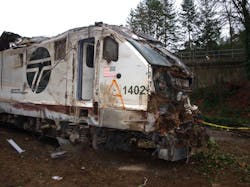NTSB issues final report on Amtrak train derailment in Washington State
The National Transportation Safety Board (NTSB) recently issued a final report detailing its investigation into the derailment of an Amtrak train near DuPont, Washington, that took place Dec. 18, 2017—which led to the deaths of three people and dozens of others injured.
The report details the circumstances surrounding the accident, the safety issues to be addressed as a result, and which entities the NTSB holds responsible for the events that led to the derailment.
In the executive summary of its findings, the NTSB determined that the probable cause of the Amtrak derailment was due to the failure of Central Puget Sound Regional Transit Authority to "provide an effective mitigation for the hazardous curve without positive train control in place, which allowed the Amtrak engineer to enter the 30-mph curve at too high of a speed due to his inadequate training on the territory and inadequate training on the newer equipment," the report states.
Additionally, the NTSB notes that the Washington State DOT (WSDOT) shares in responsibility for the incident as a result of its decision to begin revenue service on this line without being assured that the proper safety certifications and verifications were complete.
The report also finds that the Federal Railroad Administration's (FRA) decision to permit railcars on this track that did not meet regulatory strength requirements to be used in revenue passenger service. According to the NTSB, this led to a lack of occupant protection on board the train during the collision, resulting in passenger ejections, injuries, and fatalities.
The NTSB recommends that the FRA periodically review and update their speed limit action plans for all necessary safety mitigations, and to prohibit the operation of passenger trains on new, refurbished, or updated territories unless positive train control is implemented.
The report also recommends that WSDOT replace its passenger railroad equipment to meet all U.S. safety requirements, and that Amtrak should revise its strategies for training operators to work with new equipment and in unfamiliar territory. A statement from an NTSB board member also highlights the lack of a safety management system (SMS) program at Amtrak, something the NTSB has long recommended the implementation of across all modes of transportation.
--------
SOURCE: NTSB
IMAGE: NTSB report
